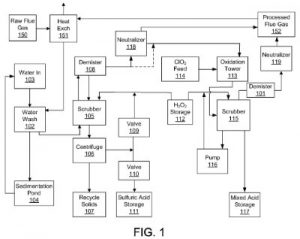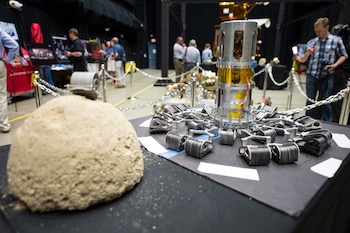At the beginning of May, American space exploration agency NASA issued a press release announcing a newly established searchable public database of NASA’s expired patents. These patents cover thousands of technologies which are already in the public domain, but NASA has made it much easier to examine its patents by operating its own portal. Also announced was the release of 56 formerly-patented technologies to the public domain so that they can be used by commercial enterprises prior to their expiration.
NASA technologies are developed to support the agency’s space exploration programs but often they end up benefitting life back here on Earth. NASA innovations in aerodynamics, astronaut nutrition and safety systems have led to tractor trailers with reduced air drag, microalgae nutritional supplements for children and flame-resistant materials for airplane seats. NASA’s mission to Mars, which will require the agency to answer much more difficult questions for supporting human life in space, will likely yield similar results in developing innovative technologies which turn out to have unexpected benefits for the wider human race. For example, a NASA project soliciting ideas for using in situ resources on Mars to support human life could lead to discoveries related to improving life in Earth’s arid climates.
Patents released by NASA into the public domain were selected based on the low likelihood that the patents would be licensed by private enterprise because of low demand for resulting products. Other patents cover technologies that require further development before products are market-ready. According to the NASA press release, these innovations include spacecraft launching components, methods of controlling airflow in hypersonic flight and human safety systems.
 NASA has also published a list of the patents which the agency has decided to open-source to the public domain, which can be accessed via the Internet. One such patent, which protects a process for the more cost-effective production of carbon nanotubes, is U.S. Patent No. 7008605, which is titled Method for Manufacturing High Quality Carbon Nanotubes. It claims a non-catalytic process for the production of carbon nanotubes which involves pumping an inert gas into a gap between two carbon rods, flushing out oxygen and preventing it from interfering with the vaporization of carbon. It also prevents the oxidation of the carbonaceous residue deposited at a carbon rod end. This production process, which does not require the use of a catalyst agent, results in carbon rods produced with fewer impurities which would have to be removed through an additional process. The invention resulted in raw samples with a 78 percent yield of carbon nanotubes at a cost of $10 per gram, proving to be much more cost-effective than conventional methods producing a 30 to 50 percent yield at a cost of $100 per gram.
NASA has also published a list of the patents which the agency has decided to open-source to the public domain, which can be accessed via the Internet. One such patent, which protects a process for the more cost-effective production of carbon nanotubes, is U.S. Patent No. 7008605, which is titled Method for Manufacturing High Quality Carbon Nanotubes. It claims a non-catalytic process for the production of carbon nanotubes which involves pumping an inert gas into a gap between two carbon rods, flushing out oxygen and preventing it from interfering with the vaporization of carbon. It also prevents the oxidation of the carbonaceous residue deposited at a carbon rod end. This production process, which does not require the use of a catalyst agent, results in carbon rods produced with fewer impurities which would have to be removed through an additional process. The invention resulted in raw samples with a 78 percent yield of carbon nanotubes at a cost of $10 per gram, proving to be much more cost-effective than conventional methods producing a 30 to 50 percent yield at a cost of $100 per gram.
 Given the growing political interest in curbing fossil fuel emissions, which includes last December’s Paris Agreement, there could be some interest in the innovation reflected within U.S. Patent No. 8425866, issued under the title Control of Emissions. It discloses a method of treating a gas stream for removal of oxides of nitrogen which involves mixing the gas stream with both a diluted chlorine dioxide, which converts nitric oxide to nitrogen dioxide, and then hydrogen peroxide solution, converting nitrogen dioxide to nitric acid which can be removed through a scrubber. The use of chlorine dioxide results in a method of scrubbing nitric acid from gas streams in a way which doesn’t require costly and chemically unstable oxidizing agents.
Given the growing political interest in curbing fossil fuel emissions, which includes last December’s Paris Agreement, there could be some interest in the innovation reflected within U.S. Patent No. 8425866, issued under the title Control of Emissions. It discloses a method of treating a gas stream for removal of oxides of nitrogen which involves mixing the gas stream with both a diluted chlorine dioxide, which converts nitric oxide to nitrogen dioxide, and then hydrogen peroxide solution, converting nitrogen dioxide to nitric acid which can be removed through a scrubber. The use of chlorine dioxide results in a method of scrubbing nitric acid from gas streams in a way which doesn’t require costly and chemically unstable oxidizing agents.
Nitrogen oxide is typically seen as a waste emission but it could be put to good use thanks to the technology described within U.S. Patent No. 6039783, entitled Process and Equipment for Nitrogen Oxide Waste Conversion to Fertilizer. It claims a process of converting vapor streams containing at least one oxide of nitrogen to a liquid fertilizer composition featuring the use of hydrogen peroxide to convert oxy acids of nitrogen into nitrate ions. A stream containing those nitrate ions is then contacted with a hydrogen peroxide solution to form a solution of potassium nitrate. This process, which can be monitored with software to run continuously, results in 99.9 percent pure potassium nitrate which is used as a fertilizer for plants or as a rocket propellant.
There definitely appears to be a diversity of innovation present in the patents released by NASA into the public domain. Solar panels which can receive reverse bias damage when solar cells are shaded could be made stronger with the innovations disclosed in U.S. Patent No. 8212138, titled Reverse Bias Protected Solar Array with Integrated Bypass Battery. Turbomachinery which rotates at high speeds, creating friction which can reduce the operating life of components such as bearings, would see their risk of fatigue failure reduce with the software technology claimed by U.S. Patent No. 7023118, System for Controlling a Magnetically Levitated Rotor. The greater ability to eliminate waste heat from power transmission and power generation systems is supported by the cooling system detailed within U.S. Patent No. 9091490, Open Loop Heat Pipe Radiator Having a Free-Piston for Wiping Condensed Working Fluid.
Of course, these patents now in the public domain are but a fraction of the thousands of NASA technologies which the agency has made more accessible through its searchable online database. A search for “emissions” brings up 39 instances of related technologies which can be freely practiced because their patents have expired. Using the search term “solar” brought up dozens of related technologies for saltless solar ponds for providing hot water, power generation turbines incorporating both wind and solar resources and solar powered aircraft. Even a search for “automobiles,” which is decidedly out of the focus of typical NASA research and development, brought up two results: one for a climate control system in a solar powered car, the other an automatic balance for dynamically rotating masses, including automobile wheels.
Although it would seem odd for private enterprise to just freely release patents which were costly to obtain, as we’ve seen Elon Musk do in the past, but NASA’s decision reflects its desire to grab interest from the private commercial sector in accomplishing its project goals. Last November, we covered remarks made by NASA Administrator Charlie Bolden indicating that developing the commercial crew program which would bring American spacecraft launches back to American soil requires private enterprise to bite off some of the pie. Coverage of a tech day at NASA’s Glenn Research Center published in late May by public media broadcaster ideastream indicated that NASA signs about 75 to 100 commercial partnership agreements each year to license technologies.
NASA will continue to work with startups who want to develop the agency’s technologies into consumer products. In fact, according to Dan Lockney, program executive at NASA’s Technology Transfer Program, the agency’s tech transfer office has been contacted primarily by startups that are looking at non-aerospace applications for the innovations. Currently, the agency is involved with around 500 active tech licenses, according to Lockney. These comments were received in an email dated July 19th updating the progress of the NASA patent licensing program.

![[IPWatchdog Logo]](https://ipwatchdog.com/wp-content/themes/IPWatchdog%20-%202023/assets/images/temp/logo-small@2x.png)


![[Advertisement]](https://ipwatchdog.com/wp-content/uploads/2024/04/UnitedLex-May-2-2024-sidebar-700x500-1.jpg)
![[Advertisement]](https://ipwatchdog.com/wp-content/uploads/2024/05/Quartz-IP-May-9-2024-sidebar-700x500-1.jpg)
![[Advertisement]](https://ipwatchdog.com/wp-content/uploads/2024/04/Patent-Litigation-Masters-2024-sidebar-700x500-1.jpg)

![[Advertisement]](https://ipwatchdog.com/wp-content/uploads/2021/12/WEBINAR-336-x-280-px.png)
![[Advertisement]](https://ipwatchdog.com/wp-content/uploads/2021/12/2021-Patent-Practice-on-Demand-recorded-Feb-2021-336-x-280.jpg)
![[Advertisement]](https://ipwatchdog.com/wp-content/uploads/2021/12/Ad-4-The-Invent-Patent-System™.png)







Join the Discussion
No comments yet.